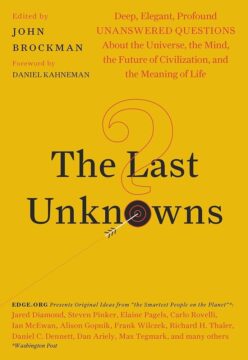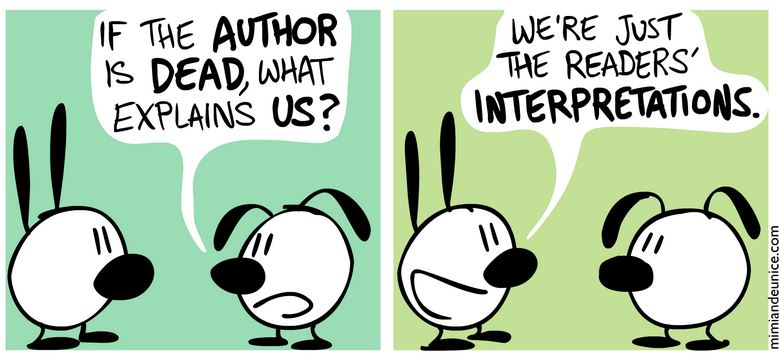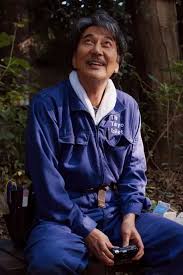 Chiharu Shiota. Infinite Memory, 2025.
Chiharu Shiota. Infinite Memory, 2025.
Dresses and ropes.
Commissioned by M+, Hong Kong, 2025.
Photograph by Sughra Raza, Nov 1, 2025.
Enjoying the content on 3QD? Help keep us going by donating now.
 Chiharu Shiota. Infinite Memory, 2025.
Chiharu Shiota. Infinite Memory, 2025.
Dresses and ropes.
Commissioned by M+, Hong Kong, 2025.
Photograph by Sughra Raza, Nov 1, 2025.
Enjoying the content on 3QD? Help keep us going by donating now.
by S. Abbas Raza and ChatGPT 5.1
 S. Abbas Raza: You may have heard of John Brockman who is a well-known American literary agent and author specializing in scientific literature. Brockman led a scientific salon for 20 years, asking an annual question to a host of scientists, philosophers, and other thinkers, and publishing their answers in book form. For the last such book, instead of asking for answers to a question, he requested that the contributors each submit one question to which they would like to know the answer, and the resulting list of questions was once again published as a book in 2018 entitled The Last Unknowns with a foreword by Daniel Kahneman. Here is the question that I submitted and was published in that book:
S. Abbas Raza: You may have heard of John Brockman who is a well-known American literary agent and author specializing in scientific literature. Brockman led a scientific salon for 20 years, asking an annual question to a host of scientists, philosophers, and other thinkers, and publishing their answers in book form. For the last such book, instead of asking for answers to a question, he requested that the contributors each submit one question to which they would like to know the answer, and the resulting list of questions was once again published as a book in 2018 entitled The Last Unknowns with a foreword by Daniel Kahneman. Here is the question that I submitted and was published in that book:
Why is sleep so necessary?

The questions were simply printed in the book with the author’s name, one to a page, without any commentary or explanation but let me give a short explicatory comment here. Much of my curiosity about sleep had to do with the word “so” in my question and the work it is doing there. One reads many accounts of what happens when we sleep. For example, the flushing of toxins from the brain, cellular repair, etc., but what I found unsatisfying was that none of these seemed to me to give good reasons we necessarily have to be unconscious for the process to take place. And the advantage one would gain from not having to be asleep for a very significant portion of one’s life would clearly be so profound that if there were any easy way evolution could have found a way around sleep, over hundreds of millions of years of reproducing different kinds of brains, it would have. But we see that any animal with a brain, no matter how tiny or complex, from fruit flies to humans, needs to sleep. That is why I asked why sleep is “so necessary”, because I suspected that the answer to that question would tell us something very fundamental about the design of the brain.
A couple of days ago, I mentioned to my wife, Margit, that a few months after GPT3 was released to the public by OpenAI at the end of November in 2022, months that I spent intensively learning about how transformer models like ChatGPT work (transformer is the “T” in GPT and a particular architecture of artificial neural networks), it suddenly occurred to me that AI models may have provided us with the conceptual vocabulary to more easily understand what is happening in the brain when we sleep. I then went on to explain to her what I meant in the following way:
Human brains are not “pre-trained” with data the way a large language model (an LLM like ChatGPT) or other types of deep-learning AIs are. Instead, the synaptic weights throughout our “thinking brain”, probably the neocortex at least, are adjusted according to our experiences throughout our life. But while we know what an artificial neural network’s learning algorithm is during pre-training (it’s called “backpropagation“), we know that in our case it is not backpropagation, but we also do not know exactly what the learning algorithm (which goes and adjusts the synaptic weights) for human brains is. Read more »
—on a painting by Edward Hopper
A flying red horse
was a sign of my time.
On drives anywhere
along a center white line
with mom and dad, when
we rolled in to fill-her-up
I’d see him there through my
backseat window as on my
couch-like seat I laid supine,
and there he’d be, flying high
way up there on a Mobile sign
on a tall white post in an
olden time when I innocently
thought life was truly sublime
when horses could fly and
all things rhymed
Jim Culleny
12/5/25

Enjoying the content on 3QD? Help keep us going by donating now.
by Jeroen Bouterse
 Preparing a worksheet with negative-number calculations where all the digits are sixes and sevens. Telling myself it’s meant to take the fun out of it for them – like a sex ed teacher having their students say ‘penis’ one hundred times before starting the unit. Definitely not the whole story, but plausible: as a middle school math teacher I am more than justified in trying to tame the phenomenon. In fact, I have drawn a firm line; just seeing a 6 anywhere in an exercise is decidedly not an appropriate reason for doing the meme. Really, we need to get on with the lesson now; I will count to five.
Preparing a worksheet with negative-number calculations where all the digits are sixes and sevens. Telling myself it’s meant to take the fun out of it for them – like a sex ed teacher having their students say ‘penis’ one hundred times before starting the unit. Definitely not the whole story, but plausible: as a middle school math teacher I am more than justified in trying to tame the phenomenon. In fact, I have drawn a firm line; just seeing a 6 anywhere in an exercise is decidedly not an appropriate reason for doing the meme. Really, we need to get on with the lesson now; I will count to five.
The ‘six-seven’ thing is one of those trends that remind adults they have lost connection with what it is like to be a teenager. For me, it is actually a far less baffling one than the draining ‘skibidi’ and ‘what the sigma’ cycles – I quite understand that it is fun to say. No, more than that; it has made something about Generation Alpha positively click into place for me. Let me enlighten you.
But before I do that, let me remind you that as a teacher, I am one of the least suitable people to look at the current cohort of middle-schoolers with any objectivity. Ten years into teaching math, part of my brain is definitely wondering why they still don’t know how to find the lowest common denominator, forgetting that every year, ‘they’ are different children who are simply learning these concepts for the first time. Also, with more teaching experience comes more confidence, so that I now tend to attribute failures in skill transfer less to my own didactic shortcomings and more to whatever is going on with kids these days.
My point is not, however, about what may or may not actually be wrong with this generation – in fact, I intend to end this essay with some starry-eyed optimism; rather, I want to proceed from the observation that this generation is the object of deep cultural worries in a way that we haven’t seen in a while. Those worries are tied to the technological revolutions that have led to kids being perpetually online. Read more »
by Daniel Gauss
 Antonio Gramsci’s theory of hegemony helps explain how the power structure of modern liberal-democratic societies maintains authority without relying on overt force. Many definitions of hegemony point out that it creates “common sense,” the assumptions a society accepts as natural and right.
Antonio Gramsci’s theory of hegemony helps explain how the power structure of modern liberal-democratic societies maintains authority without relying on overt force. Many definitions of hegemony point out that it creates “common sense,” the assumptions a society accepts as natural and right.
It works by getting inside our heads and convincing us of concepts that would not hold up under rigorous investigation. Our criminal justice system is built on such taken-for-granted principles, many of which go unchallenged despite producing deeply inhumane consequences.
Crime, for example, is assumed to be a personal “moral failing” rather than a systemic problem. Why some people (mostly poor and marginalized) fail morally is not understood or explained. Instead of understanding crime as a product of poverty, racial segregation, inequality and limited opportunity, our system treats it as evidence of bad individual character or individual moral flaws, basically recycling old theological ideas while ignoring more than a century of psychology and sociology.
The judicial system still draws from an outdated worldview, uninformed by social science, that assumes the validity of an unquestioned social hierarchy, based on inequality of opportunity, and shifts responsibility onto individuals who are often living in trying and corrosive conditions. This amounts to a form of blaming the victim instead of accepting social and economic responsibility for others. Read more »
by Jerry Cayford
Dear Governor Schwarzenegger and Common Cause,

California just passed Proposition 50 to resurrect partisan gerrymandering. The two of you had worked hard and worked together, in 2008 and 2010, to take electoral redistricting out of the hands of partisan legislators and give it instead to a citizens commission. You shared the goal of saving our democracy from the anti-democratic one-party rule you both saw coming. Yet, in 2025, you were on opposite sides of the Prop 50 battle. Although you collaborated to create citizens commissions, you worked against each other in the decision to tear those commissions down.
There is nothing mysterious about your change from collaborators to opponents. That decision on commissions presented the classic dilemma: damned if you do and damned if you don’t. There’s no surprise that you chose differently when only bad choices were available.
Prop 50 explicitly announces that gerrymandering California for the Democrats is a response to the Republican Texas gerrymander. With eyes wide open, everyone knows this race for partisan advantage is a race to the bottom for democracy, and that large parts of the American public will find themselves unrepresented and powerless. It’s a bad course of action. Damned if you do. However, not entering this race to the bottom would, Common Cause reasons, “amount to a call for unilateral political disarmament in the face of authoritarian efforts to undermine fair representation and people-powered democracy.” Damned if you don’t.
You are leaders who understand the bottom we are now racing toward. I write to argue that there is still a path out of damnation, a path America can take before the 2030 census. I ask you to lead us on it. It is a straight and narrow path, as paths from damnation often are. You have both already seen the narrow part: redistricting must be national, the same in all states. I hope to convince you that the straight path to a nation-wide end to gerrymandering, our best path to a healthy democracy, does not wind through citizens commissions. I will touch on morals, masculinity, math, and more to describe this better path. Read more »
by David Winner

August 2009, rainy season in Senegal, my friend Robert and I are trying to get from Dakar to Saint Louis, the former capitol of French West Africa. We take the taxi parked outside of our hotel to the Gare Routière where sept-places (old station wagons with their backs carved into claustrophobic seats) head to destinations across the country once seven passengers have assembled. On the way, the driver explains a problem to us, a difficulty that lies outside the realm of my limited French.
Inside the Gare, we see cars, drivers, and even the names of destinations (including Saint Louis) but something is off. There are hardly any people about.
Following us into the station, the driver repeats what he’s said before. And a word that I had not grasped, greve, strike, finally penetrates my foggy brain. No sept places are running today because they are on strike.
According to what I’ve read, police harassment, unlicensed vehicles, bad roads hound Senegal, transportation a chronic challenge.
What the driver wants, I assume, is for us to pay him to take us all the way to Saint Louis. But he seems hesitant when I make that suggestion. And when he finally agrees, he only asks for only a hundred dollars for the nearly four-hour drive there. And back, as he surely lives in or around Dakar. Read more »
by Charles Siegel

Last month I attended two conferences a week apart, one in Norway and one in Italy. The first conference was held in Bergen. From there, my law partner and I proceeded down the coast to Stavanger, for a meeting with a lawyer there about some potential cases.
Our meeting was late on the afternoon of November 16th. When we finished, we looked around for somewhere to have dinner. Most restaurants were closed on a Sunday evening in autumn, but eventually we found a decent place. As we walked back to our hotel afterward, we passed a pub and decided to go in and watch the soccer match that was playing on TV.
This turned out to be a World Cup qualifying match between Norway and Italy. There wasn’t actually much riding on the outcome; Norway was going to qualify unless it lost by nine goals or more, and Italy was going to stay alive but have to win an extra two matches to qualify, as part of an additional playoff round for European teams. But the fans in the pub were excited nonetheless.
When we sat down, the game was about midway through the second half, and the score was 1-1. It was clear, of course, that Norway was not going to lose by nine goals or anything close to that, and so they were going to the World Cup for the first time in 28 years. But even as the clock ticked down toward qualification, those in the pub still were hoping for a win.
And they got it, in lightning fashion: Erling Haaland, the bustling striker who plies his trade in the Premier League for Manchester City, scored two goals in two minutes. Norway added a fourth in stoppage time, and that was it. Jubilation for the Norwegian players, many of whom weren’t alive the last time Norway played in a World Cup, and humiliation for Italy, who were beaten at home and who now are in danger of missing the tournament for a third time running. Read more »
by Eric Feigenbaum

Singapore’s domestic debate is a matter for Singaporeans. We allow American journalists in Singapore in order to report Singapore to their fellow countrymen. We allow their papers to sell in Singapore so that we can know what foreigners are reading about us. But we cannot allow them to assume a role in Singapore that the American media play in America, that is, that of invigilator, adversary and inquisitor of the administration. No foreign television station had claimed the right to telecast its programs in Singapore. Indeed America’s Federal Communications Commission regulations bar foreigners from owning more than 25 per cent of a TV or radio station. Only Americans can control a business which influences opinion in America. Thus, Rupert Murdoch took up US citizenship before he purchased the independent TV stations of the Metromedia group in 1985.
When Singapore’s Founding Prime Minister Lee Kuan Yew spoke these words to the American Society of Newspaper Editors meeting in 1988, he could scarcely have imagined how the Internet and eventually social media would dramatically affect the very nature of the press and increase the number of voices engaged in political and other discourse.
Today not only is media ubiquitous but choosing your news and information sources to align with your pre-existing political and social outlook is not only available, but the norm. If the role of the Fourth Estate as a credible source of information has been compromised, it is equally undermined by hostile voices and even less credible sources able to find megaphones through social media. The information age is a din of voices making it harder than ever to get clear, unbiased news.
Media itself is now a topic in our national discourse. On October 29th, the Pew Research Center published findings that “only 56 percent of American adults now say they have a lot of or some trust in the information they get from national news organizations – down 11 percentage points since March 2025 and 20 points since we first asked this question in 2016.”
Further, “fewer than half of Republicans and Republican-leaning independents (44 percent) now say they have at least some trust in the information that comes from national news organizations. This is down from 53 percent in March and 70 percent in 2016, but it’s still above its lowest point in 2021, when 35% of Republicans expressed this level of trust in the national media.”
And Democrats? Read more »
Winter scene in Franzensfeste, South Tyrol.
Enjoying the content on 3QD? Help keep us going by donating now.
by Akim Reinhardt
 Art is dangerous. It’s time people remembered that and recognized the fullness of it. For if art is to remain important or even relevant in the current moment, then it’s long past time artists stopped flashing dull claws and pretending they had what it takes to slice through ignorance. We need them swallow their feel-good clichés and to begin sharpening their blades. We need dangerous art, and we cannot afford much more art that its creators believe is dangerous when it is not.
Art is dangerous. It’s time people remembered that and recognized the fullness of it. For if art is to remain important or even relevant in the current moment, then it’s long past time artists stopped flashing dull claws and pretending they had what it takes to slice through ignorance. We need them swallow their feel-good clichés and to begin sharpening their blades. We need dangerous art, and we cannot afford much more art that its creators believe is dangerous when it is not.
When people say Art is dangerous, they’re often bragging. Talking it up like a super hero. Evil had better beware: Art is here to save the day!
Oh my, she gasped, clutching her pearls. Why, how could art possibly do that?
Because it’s dangerous! It reveals the evil that masked villains seek to hide!
Such sentiments are naive. They are wishful thinking. And those sentiments are actually far more dangerous than the art typically produced by those who espouse such sentimets. Supposedly dangerous art often does little more than preach to the choir or wrap important points up in obfuscations that most audiences lack the inclination or even the background to unravel. Instead of puncturing sacred cows or shining a bright light on dark evils, much “dangerous” art merely creates illusions of damage amid billows of self-congratulation and self-satisfaction. When the smoke clears, all the same problems remain, and no one, save for perhaps professionals and other insiders of various art worlds, are any more enlightened, while the problems that had been targeted with “dangerous” art quietly and stubbornly linger. Read more »
by Marie Snyder
 Emma Wilkins’ excellent piece “On Housecraft” in The Philosopher, discusses Helen Hayward’s book, Home Work: Essays on Love & Housekeeping in such a compelling way as to provoke some thoughts without having actually read the book in question. So this is a critique of a review of a book I haven’t read, but on a topic most of us relate to intimately.
Emma Wilkins’ excellent piece “On Housecraft” in The Philosopher, discusses Helen Hayward’s book, Home Work: Essays on Love & Housekeeping in such a compelling way as to provoke some thoughts without having actually read the book in question. So this is a critique of a review of a book I haven’t read, but on a topic most of us relate to intimately.
Like me, and many of us, Wilkins hates cleaning and is working through how to make the drudgery more palatable. She’s “more likely to make the bathroom less dirty than property clean.” Likewise, to take the confessions even further, cobweb strands are clearly visible from where I’m currently sitting in my kitchen.
Wilkins and Haywood raise a long-standing struggle for fairness in this field and pin the problem on daily chores being beneath our dignity, so they explore elevating the art of cleaning and finding personal benefits in the work. These paths might help, but I wonder if it could also help to revere the battle around equity and to lower and ground this regular exertion.
Haywood has found a way to embrace housework as a method of demonstrating caring. As an artform, it can become a noble pursuit to have a well-kept home. Wilkins writes that our disdain for chores is relatively new as Aristotle recognized that,
“…’oikonomia’ or ‘household management’ contributed to the wellbeing of the community, thereby serving a higher purpose. … It’s not surprising that, in a secular individualistic culture, cultivating servant-hearted humility holds little appeal. Work done in the home might not earn us money, or praise, or even gratitude. But the more we’re motivated by care, and love, the more noble the work is.”
Wilkins later states her position: “I can’t see our attitudes to the work itself changing any time soon.” Instead, she hopes to endure the grind by seeing the work as personally beneficial: “Far from being a ‘waste’ of time, it could be time spent thinking, reflecting, practising, and learning. It could benefit our health as well.” If we hate that the dishes need doing again, at least we can reap some side benefits from it, like hitting our fitness goals by working our wax-on-wax-off muscles. I used this line of reasoning when I had little ones who always wanted to be in my arms. I was getting buff from carrying them around! Read more »
by Herbert Harris

Many years ago, I began a meditation practice, sparked by curiosity and vague, middle-aged worries about stress and blood pressure. To my surprise, it quickly became a regular part of my life. I restlessly explored many forms of meditation and meditation groups, eventually coming to the San Francisco Zen Center. Before long, I found myself seated on a black cushion in the meditation hall each morning at 5:30. Twenty years later, and 2,500 miles away, I have a much more relaxed schedule, but I am still at it.
What is it like to meditate? This is a question I am constantly asked. Would a philosopher or scientist say there’s a distinct state of consciousness with its own special qualia? I don’t know. Maybe I’ve been doing it wrong, but meditation has never given me an experience that I would call altered consciousness. I’ve come to think the more interesting question is not what meditation feels like moment to moment, but what it is like to be a meditator, to live a life punctuated by these quiet, unremarkable moments of sitting still.
There are many ways our minds can store the details of our experience. We put facts and figures in one place, sensory experiences in another, and skills and procedures in yet another. There is a special kind of memory, called episodic memory, that holds not just the information about an event, but also a sense of our being there. Recalling episodic memories gives us a faint sense of time travel. These are the memories we can reinhabit. We remember a beach vacation as if we can feel the warm sand between our toes, hear the gulls above, and sense the light breeze on our skin. They have a lived-through quality, a presence that feels like “me.”
I have a torrent of episodic memories from my time in San Francisco, where I had just started a new job. I felt like a tourist; every street, every café, every meeting at the new company introduced a parade of unfamiliar faces. My memory was overloaded with experiences and sensations. It felt like my life had entered a new incarnation, complete with a new cast of characters I had to learn. As I stepped into a new role, I became, to some extent, a different person as I adapted to meet new duties and responsibilities. I was surrounded by people who each had hopes and expectations that I would be a good employee, a respectable colleague, and a friend. These hopes and expectations exerted palpable influences on my sense of self.
In the meditation hall, expectations were few. Read more »
by Mark R. DeLong

“People tell me that I could do much better,” David McCullough said in an interview included in California Typewriter, a documentary about typewriters “and the people who love them.” “I could go faster and have less to contend with if I were to use a computer—a word processor—but I don’t want to go faster. If anything, I would prefer to go slower.” He liked the straightforward mechanism of his Royal Standard Typewriter that he bought, used, in 1965 for about twenty-five dollars. “To me, it’s understandable: I press the key and another key comes up and prints a letter on a piece of paper and then you can pull it out. It’s a piece of paper upon which you have printed something.
“You’ve made that. It’s tangible. It’s real.”
That tangible quality, that reality comes clear in Richard Polt‘s Typewriter Manifesto, which concludes with a series of contrasts of typewriter life and digital life (using the red and black colors of some typewriter ribbons):
We choose the real over the representation,
the physical over the digital,
the durable over the unsustainable,
the self-sufficient over the efficient.
And then the manifesto concludes, “THE REVOLUTION WILL BE TYPEWRITTEN” of course.
Keyboards are keyboards, you might say. It’s the fancy stuff behind them that matters. Typewriters also have had their incremental improvements, electrification being the most obvious and, less obvious perhaps, the improvements on font rendering. The old fashioned levered hammer bearing the inverse shape of letters gave way to ingenious “balls” as in the IBM Selectric and “printwheels” that look like a miniature, heavy-duty bicycle wheel with spokes that bear the letters. (My own old typewriter has this technology.) These innovation allowed for font changes and vastly improved print typesetting. That story about the ingenious QWERTY keyboard layout minimizing key jambs and speeding production of words? I’d say, probably false. A more likely reason for that innovation was probably a simple marketing trick: a salesman who didn’t know how to type could still peck out T-Y-P-E-W-R-I-T-E-R using only the letters on the top row. Read more »

Dear Reader, there are no algorithms at 3QD—just six human editors trying to keep a human-curated corner of the internet alive. But recent changes in Google search and other AI-driven shifts have cut our already modest advertising revenue to less than half of what it was just last year. 3QD remains mainly a labor of love, but we do need enough income to cover basic costs.
If you value what we do, please consider supporting 3QD with a contribution by clicking here. Thank you in advance!
by Michael Liss
In the autumn of 1929 the mightiest of Americans were, for a brief time, revealed as human beings. —John Kenneth Galbraith, The Great Crash 1929

Ah, the mighty. The great, and the powerful. Let us take a moment to remember the mightiest of 1929. Among them surely had to be Herbert Hoover, the embodiment of a certain type of American success story, orphaned at an early age, a man who had literally worked in a mine for $2.50 per day, and, through inexhaustible, sustained effort tied to limitless ambition, had become a successful mining engineer, then internationally renowned for his rescue efforts during and after World War I, then, in eight highly impactful years, as Commerce Secretary. Almost by popular demand, he became the 31st President of the United States.
On Monday, March 4, 1929, he took office, declaring, in his Inaugural, these two ringing sentences:
In the large view, we have reached a higher degree of comfort and security than ever existed before in the history of the world. Through liberation from widespread poverty we have reached a higher degree of individual freedom than ever before.
Heady words, heady times, and perhaps just the slightest touch of hubris that wisdom might have suggested should be delivered in a less public way. The Gods have their own ways of seeing things, and of settling accounts, and Herbert Hoover, and the country he now led, were about to experience that.
Let’s scroll forward to December 3, 1929, barely nine months into his term, a bit more than a month after the wrenching horror of Black Thursday, October 24th and Black Tuesday, October 29th. Hoover delivers (literally, in writing, without pomp and circumstance) his first Annual Address to Congress.
It is, like most of its kin from George Washington’s to those of the present day, a ponderous thing. Hoover is a man of duty, and this effort, running to 11,000 words, is encyclopedic in its topics, and replete with dignified praise of both country and self. Read more »
by Rafaël Newman

Some of the best new music is 100 years old. On October 21, 1925, the Anglo-American composer and violist Rebecca Clarke presented a program of her own compositions at London’s Wigmore Hall:
Sonata for Viola and Pianoforte
Trio for Pianoforte, Violin and Violoncello
“Midsummer Moon” and “Chinese Puzzle” for Violin and Pianoforte
Songs, including “The Seal Man”, Old English Songs with Violin and others.
The Sonata had shared first place in a prestigious competition a few years earlier. Its score is prefaced by an epigraph, drawn from Alfred de Musset’s La Nuit de Mai, which stakes the young composer’s ambitious claim to innovation within an august tradition:
Poète, prends ton luth; le vin de la jeunesse
Fermente cette nuit dans les veines de Dieu.
(Poet, take up your lute; the wine of youth
this night is fermenting in the veins of God.)
Clarke herself played the viola at the sold-out 1925 performance of her Sonata, which headlined the bill of other original works of chamber music. The Sonata for Viola and Pianoforte was to become “a cornerstone of the viola literature…and nowadays is considered a masterpiece,” and Clarke would go on to be a celebrated figure on the early 20th-century English musical landscape.
When she was trapped by the Second World War in the United States, during a family visit, and was unable to obtain a visa to return to her native United Kingdom, Clarke continued to compose, despite the uncomfortable circumstances of her unexpectedly prolonged lodgings with in-laws. But the renown she had enjoyed as a composer in the early decades of the 20th century began to decline in the postwar period, as reflected by the drastic reduction in space accorded her by subsequent editions of the seminal Grove Dictionary of Music and Musicians, which demoted her, with patriarchal brutality, from autonomous artist with her own detailed entry in the 1920s to a footnote identifying her only as the wife of the composer James Friskin in the 1980s. Read more »
“The best evidence we have suggests that early Earth was completely covered by oceans, but to link two amino acids together to make a protein, you have to remove water.” And that would have been impossible if the amino acids were immersed in an ocean. Life needed some land—literally a beachhead—to get started.” —geobiologist, Joseph Kirschvink
though landbound we were once
tiny ships, submarines. we understand the sea.
it undulates within-around us. minds bob on timeswells.
we’re swept by winds that toss and grind us.
not flawlessly designed, we’ve weak
moments in our hulls. tempted,
we run perilously close to rocky spits,
each one adrift looking for a beachhead,
longing for a place that’s still while
everything around us shifts.
like Noah’s searching dove
scanning for a patch of earth
where sea is parted.
where past is dead,
where present sits,
where luck and love
might be restarted
Enjoying the content on 3QD? Help keep us going by donating now.
by Christopher Horner

Here’s an imaginary conversation, based on real ones that I’ve heard or taken part in. The names I use mainly relate to the USA and UK, but the points apply more widely than that.
All these mugs voting for Trump, or Reform, Le Pen and so on. They either don’t know the truth, or don’t want to know it – and they vote for grifters that don’t represent their best interests. Right wing populists get into power, promise to improve things, then just reward their super rich buddies. I despair: these people are just watching fake news on Fox, GB News etc, and swallowing the lies.
You need to ask deeper questions than that. What was the state of things before the rise of these ‘grifters’? People didn’t suddenly become stupid 10 years ago. In fact, I don’t think ‘stupid’ has much to do with it.
Isn’t voting for Trump or Brexit stupid, since he is an obvious liar and Brexit was an obvious con?
There’s more to it than that. See how things got this way. Places like the UK, the USA etc have been ruled for decades by a managerial elite, one a bit to the Right, the other very slightly Left. In all those years, what did they do to enhance public trust in politicians? Look at the Iraq war, for instance. People were lied to. Or the enormous increases in inequality – think of the rust belts created by the wholesale embrace of ‘globalisation’. People were either told that the money didn’t exist to fix the problems, or that the problems didn’t exist at all. The message received was ‘you don’t matter’. Meanwhile lobbyists poured money into ‘their’ politicians and who then furthered the interests of the 1%, who clearly did matter. The result was a loss of trust in democracy itself. A class of elite politicians with more in common with each other than with most citizens. A minority did very well out of this: the majority did not. Read more »